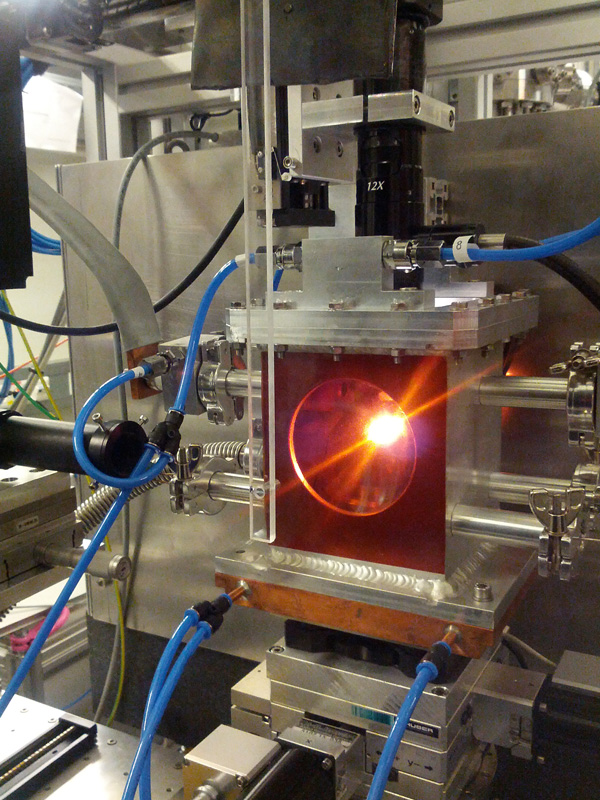Diamonds, X-rays, and lasers aren’t just for detective dramas filled with heists and hijinks. They are among the tools that experimental petrologists use to re-create conditions in Earth’s mantle, whose mysteries remain mostly hidden many hundreds of kilometers below the surface.
Davemaoite may be surprisingly soft in the only place with high enough pressures and temperatures where it can easily exist—Earth’s lower mantle.
In work reported recently in Nature, scientists led by Julia Immoor used these tools to create an elusive mantle mineral in the lab—davemaoite, also called cubic calcium silicate perovskite. After synthesizing the finicky mineral, they then deformed it to measure its strength—a technical breakthrough, said Sang-Heon “Dan” Shim, a mineral physicist at Arizona State University who was not involved in the new study. In their analysis, Immoor and her colleagues discovered that davemaoite, which exists naturally only between about 660 and 2,900 kilometers below Earth’s surface where pressures and temperatures are high enough, may be surprisingly soft. The finding raises intriguing questions about roles the mineral could play in subduction and the formation of seismically anomalous regions in the lower mantle.
Under Pressure
Davemaoite is the third most abundant mineral in the lower mantle, yet it’s notoriously difficult to study because of its instability at Earth’s surface, said Shim.
The problem, said corresponding author Hauke Marquardt of the University of Oxford, is that to truly be davemaoite, the mineral’s crystal structure must be cubic, which means that the smallest repeating arrangement of atoms, called the unit cell, must form a cube. However, under natural conditions at Earth’s surface, davemaoite’s unit cell stretches in one direction, forming a rectangular prism, not a cube. Called tetragonal calcium silicate perovskite, this warped davemaoite-esque material shows great strength under mantle pressures while at room temperature.
Creating the high pressure expected at 1,200 kilometers deep—firmly within the range at which davemaoite forms—is relatively simple. All Immoor needed was a diamond anvil cell, in which the tip of one diamond is compressed against another, with a smidge of sample powder composed of calcium, silicon, and oxygen between the two. Such a setup can reach pressures well beyond those occurring at Earth’s greatest depths. Once the experiment reached the target pressure (about 30 gigapascals), she and her colleagues turned up the temperature.

However, reaching the high temperatures of the lower mantle is more complex. Lasers used to heat samples can result in uneven heating, so Immoor and her team used a resistance heater made of two graphite sheets that allowed them to raise the temperature to a consistent 1,150 K—nearly 900°C—while also ensuring enough space for an X-ray beam to pass. The X-ray beam, said Marquardt, served as a probe of the compressed sample’s mineralogy by allowing the periodic collection of X-ray diffraction patterns during the experiment, providing confirmation that davemaoite both formed and deformed.
For a successful experiment, every piece of the apparatus must be precisely placed, the temperature must be carefully monitored, and, scientists said, fingers must be crossed that the diamonds in the anvil cell don’t break.
During a 10- to 12-hour experiment that extended into the wee hours of the morning, Immoor described how, just as a colleague was considering heading home to sleep, she and her team realized they couldn’t leave. “We knew, at this moment, that we were able to synthesize this cubic calcium perovskite,” she said. And then they deformed it. Unlike other synthetic minerals that can be quenched and studied outside the diamond anvil cell, davemaoite would revert to its warped, tetragonal relative. To that end, Immoor and her colleagues continued the experiment, watching how the impinging diamonds deformed the fresh davemaoite.
From their data, after numerous rounds of checking their calculations, the researchers found that unlike its noncubic cousin, davemaoite’s strength and viscosity are substantially lower than those of the other minerals (bridgmanite and ferropericlase) that make up the lower mantle. The finding was a surprise, Immoor said.
Blobs or Folds?
When slabs of oceanic lithosphere—comprising crust and the uppermost mantle—slide into subduction zones, scientists surmise their eventual fates from theory, experiments, and tomography, in which seismic waves help image Earth’s innards, like a global CT (computed tomography) scan. But why and how some features form in the mantle remain unclear. The new findings about davemaoite may shed light on these deep mysteries.
Though the entirety of a slab of oceanic lithosphere would weaken upon reaching the lower mantle, the crustal component should contain more davemaoite than the corresponding portion of upper mantle. Considering this compositional difference, it’s possible that the weaker former crust could peel away, or delaminate, from its erstwhile mantle partner, said Marquardt, with the crustal portion falling to and accumulating at the core-mantle boundary. This process might explain the existence of tomographically observed large low-shear-velocity provinces (LLSVPs), he said. These blobs, which cover about a quarter of the core-mantle boundary, might in turn help explain the curious chemistry of hot spot volcanoes.
These slabs might be folding like toothpaste.
However, said Karin Sigloch, a seismic tomographer at the Centre National de la Recherche Scientifique Géoazur laboratory in Sophia Antipolis, France, who was not involved in this study, oceanic crust is such a small component of subducted slabs that it may not explain the voluminous presence of LLSVPs. Instead, she said, it might be more likely that weakened, delaminated crust—if it exists—ends up forming smaller features known as ultralow-velocity zones.
Formation of davemaoite may alternatively explain the observation that subducting slabs appear to thicken when they reach the transition between the upper and the lower mantle (corresponding to depths of about 550–700 kilometers), said Sigloch. These slabs might be folding like toothpaste, just where davemaoite begins to appear, she said.
When slabs are only as strong as their weakest part, their deformation, or even their disintegration, becomes increasingly plausible.
—Alka Tripathy-Lang (@DrAlkaTrip), Science Writer

